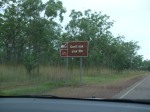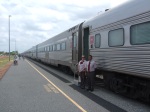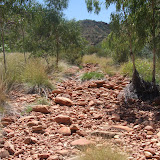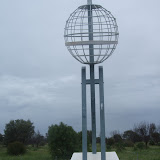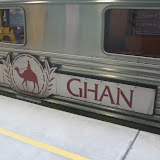 |
| Ubirr |
Kakadu is equally as famous for being the place where humanity originally entered Australia some 70000 years ago, as it is for the 2000 year old wetlands that now cover most of the low lying area. I had booked myself on a tour this day to Ubirr, a rocky outcrop in the flood plain where the aborigines had lived and painted on the rocks for some 50000 years. I had an early start as I had to meet the tour back up the road in Jabiru. The old man who had asked to sleep in my room the night before was still sat outside my room when I got up at 6am, still surrounded by beer cans.
The tour bus looked looked like it was built to handle anything. Our guide briefly went through how the radio and satellite phones work in case there is an emergency and he is incapacitated (I think he was only half-kidding, Australia is a dangerous place). We first went for a quick trip to look at the uranium mine from its perimeter. The guide explained the mine pre-dated the area being a national park. The land is owned by the local aboriginal people, who were not happy about the mine though have welcomed the income they receive from leasing the land to the mine company. It is open cast, and the hole in the ground is over 200m deep, sufficient that we could not see the bottom. The agreement with the landowners is that the hole will be filled in and area restored after the mining is complete, as much to appease the gods as for aesthetic reasons, and indeed the mine itself had already moved a couple of times in in history, and you would not have noticed from looking at its previous sites.
The mine uses a fair amount of water in its industrial processes, which is cleaned in a sequence of three holding ponds before being returned to the environment. The last of these ponds looks like a natural lake, and the landowners have requested that this is the one thing from the mine they want left when it finally shuts down. It is teaming with wildlife, including crocodiles. Mostly these are freshwater crocodiles, largely harmless to humans because they are too small (i.e. only up to 2m), but if a saltwater crocodile moves it, it is trapped and killed (the body then given to the aboriginal land owners) for health and safety reasons. This final holding pond has Styrofoam buoys dotted around it that the crocs like to bite. Monitoring the bitemarks reveals what type and what age the crocodiles currently living in the pond are.
We then stopped in one of the park’s two visitors centres for a coffee and to pick up supplies for lunch. I had initially thought the bus would take us all the way to Ubirr, as it looked like it could cope with flooding, but we were told the bus would only take us part way where we would be met by a boat to take us to the other side. A press cutting in the visitors centre showed why. Only a month before some German tourists had rented a 4×4 and tried driving along the road to Ubirr. They clearly hadn’t noticed the water depth signs, as only a few metres into the floodwater it was up to the roof. The photo showed them sitting on the roof awaiting rescue. And remember, these waters are full of saltwater crocodiles. The press cutting was too faded to photograph, but I did take one detailing the state of the roads in the park.
When we got to the boat, our guide told us to keep at least three metres from the water’s edge (how far a croc will strike) and to board the boat one at time. The boat was piloted by two aboriginal guides, who explained to in great detail how traditionally the local people survived in the park. Amongst the hundred and one uses for water lilies, their 3m stems make a tasty addition to salad (flavour like cucumber, texture like celery). After mentioning that they would make a small canoe out of the bark of a gum tree, I asked how they would cope with the crocodiles, which would easily overturn such a canoe, and are known to attack the larger aluminum fishing boats. The two guides said that while one person was paddling the canoe, the other would be keeping watch with a spear.
At the other end of the flooded road another bus was waiting for us. Presumably it just gets left there at the start of the wet season, topped up by the occasional can of diesel. The area immediately around Ubirr is fenced off, and there is a logbook at the gated entrance on the road. Our guide stopped to fill it in, only to discover that ants had turned the metal box that housed the log into a nest. And then off to the rock art.
I had mixed feelings about the rock art. I appreciated both its various styles, culturally why the aborigines made the paintings, and the sites where it was done. I think my complaint was that it is marketed as 50000 year old paintings, whereas most of them clearly are not. Our guide was even making the point that the age of the paintings is not valued by the aborigines, who own them, and would happily overpaint an existing painting (not sure if they do that anymore, as Ubirr is a world heritage site and any damage a criminal offence in Australia). Still the paintings were interesting, as was the 360 degree view from the top of the rocky outcrop that forms Ubirr. Although there was much greenery to be seen below us off to the horizon, from just having come through it we knew it was all flooded, an impressive sight.
After a packed lunch, we started our return journey. We had seen quite a bit of wildlife during our trip, but the hope is always to come across a crocodiles (at a healthy distance). During the dry season it is a lot easier, as the flooding disappears, and the crocs and other wildlife have to share the ponds that are left (known to all Australians as billabongs). But in the wet season they have the full 20000 square kilometres to move around in. Still, the wet season is also breeding season for the saltwater crocs, so the guided tours like ours usually rely on a female croc guarding a nest. I think our guide was a slightly embaressed when the nest we went to see didn’t have a female on top of it. He did say that the female would be nearby, and know that we were there. As they frequently took groups to look at he nest, the croc was not too concerned, as if she had been, she would have had no difficulty jumping into our boat to defend the nest. A sobering thought. We also unexpectedly came across a large 4.5m croc, but it swam away before we could get a good look.
After the tour, I stayed in Jabiru for supper, as it was much cheaper than my isolated resort. On the way home came across a lone dingo wandering around, looking a little starved. It was oh-so-tempting to feed it, but I was reminded of the signs back in King’s Canyon and left the dingo to its fate.
The aboriginal family were still at the resort when I returned, though the old man had apparently gone home. I was talking to them about the tour and crocodiles, and remembering that our guide had said during the day that crocs regularly walk 2km overland at night, commented on the fact that the floodwater in our resort ended only a few hundred metres from our tin hut. Oh yes, they replied, there had been a 4m crocodile just over there last week. And then they started telling me about the tree snakes. And there had been me happily wandering around the ground in the middle of the night to find the toilet.



